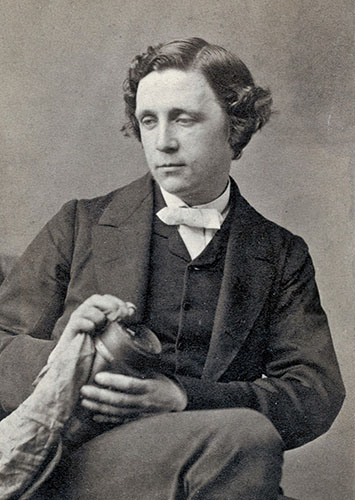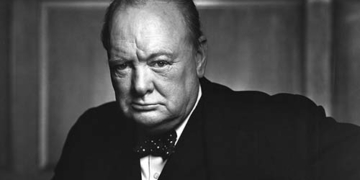Share via:

Charles Lutwidge Dodgson (1832 – 1898), better known by his pen name Lewis Carroll, was an English writer of children’s fiction, notably Alice’s Adventures in Wonderland and its sequel Through the Looking-Glass. He was noted for his facility with word play, logic, and fantasy. The poems “Jabberwocky” and The Hunting of the Snark are classified in the genre of literary nonsense. He was also a mathematician, photographer, inventor, and Anglican deacon.
Lewis Carroll came from a family of high-church Anglicans, and developed a long relationship with Christ Church, Oxford, where he lived for most of his life as a scholar and teacher. Alice Liddell, daughter of the Dean of Christ Church, Henry Liddell, is widely identified as the original for Alice in Wonderland, though Carroll always denied this. Scholars are divided about whether his relationship with children included an erotic component.
In 1856, Dean Henry Liddell arrived at Christ Church, bringing with him his young family, all of whom would figure largely in Dodgson’s life over the following years, and would greatly influence his writing career. Dodgson became close friends with Liddell’s wife Lorina and their children, particularly the three sisters Lorina, Edith, and Alice Liddell. He was widely assumed for many years to have derived his own “Alice” from Alice Liddell; the acrostic poem at the end of Through the Looking-Glass spells out her name in full, and there are also many superficial references to her hidden in the text of both books. It has been noted that Dodgson himself repeatedly denied in later life that his “little heroine” was based on any real child, and he frequently dedicated his works to girls of his acquaintance, adding their names in acrostic poems at the beginning of the text. Gertrude Chataway’s name appears in this form at the beginning of The Hunting of the Snark, and it is not suggested that this means that any of the characters in the narrative are based on her.
Before this, the family of friend and mentor George MacDonald read Dodgson’s incomplete manuscript, and the enthusiasm of the MacDonald children encouraged Dodgson to seek publication. In 1863, he had taken the unfinished manuscript to Macmillan the publisher, who liked it immediately. The illustrations this time were by Sir John Tenniel; Dodgson evidently thought that a published book would need the skills of a professional artist.
The overwhelming commercial success of the first Alice book changed Dodgson’s life in many ways. The fame of his alter ego “Lewis Carroll” soon spread around the world. Late in 1871, he published the sequel Through the Looking-Glass, and What Alice Found There. (The title page of the first edition erroneously gives “1872” as the date of publication.) Its somewhat darker mood possibly reflects changes in Dodgson’s life. His father’s death in 1868 plunged him into a depression that lasted some years.
Dodgson’s existence remained little changed over the last twenty years of his life, despite his growing wealth and fame. He continued to teach at Christ Church until 1881 and remained in residence there until his death. Public appearances included attending the West End musical Alice in Wonderland (the first major live production of his Alice books) at the Prince of Wales Theatre on 30 December 1886. The two volumes of his last novel, Sylvie and Bruno, were published in 1889 and 1893, but the intricacy of this work was apparently not appreciated by contemporary readers; it achieved nothing like the success of the Alice books, with disappointing reviews and sales of only 13,000 copies.
Charles Dodgson died of pneumonia following influenza on 14 January 1898 at his sisters’ home, “The Chestnuts”, in Guildford in the county of Surrey, just four days before the death of Henry Liddell.
Lewis Carroll – First Editions Identification Guide
This list does not include Carroll’s various mathematical works and other minor works. For a more throughout list and details, please refer to reference section.
| Year | Title | Publisher | First edition/printing identification points |
|---|---|---|---|
| 1860 | A Syllabus of Plane Algebraic Geometry | Oxford: Printed by James Wright, MDCCCLX | First edition. Black cloth, white paper label on the back. White end papers. |
| 1865 | Alice's Adventures in Wonderland | London: Macmillan & Co., 1865 | First edition. Red cloth, gilt lettering. The first print run of 2000 copies was held back because John Tenniel objected to the printing quality. These sheets was sold to the New York publishing house of D. Appleton & Co. for the American edition. Extremely rare as most are recalled. ALSO: New York: D. Appleton & Co, 1866. First American edition. Red cloth, gilt lettering. This issue used the English's First edition cancelled sheets with a new tipped-in title page dated 1866. ALSO: London: Macmillan & Co., 1866. Second English (First published) edition. Red cloth, gilt lettering. 2000-4000 copies printed. ALSO: London: Macmillan & Co.: (A) 3rd edition, 1867 (5th-7th thousand) (B) 4th edition, 1867 (8th-9th thousand) (C) 5th edition, 1868 (10th-11th thousand) (D) 6th edition, 1868 (commencing with 12th thousand). This was the first electrotype edition, published October 1868, and was the basis of all impressions until the work was reset as the ninth edition. (E) 7th edition, 1886 (commencing with 79th thousand) (F) 8th edition, 1891 (commencing with 84th thousand) (G) 9th edition, 1897 (commencing with 86th thousand). This eighty-sixth thousand published in 1897 represents Dodgson’s finally revised edition of the book. |
| 1869 | Phantasmagoria and Other Poems | London: Macmillan & Co., 1869 |
|
| 1869 | Alice’s Abenteuer | London: Macmillan und Comp., 1869 | First German edition. Green cloth, gilt lettering, all edges gilt. Two issues, priority as listed:
|
| 1869 | Adventures d'Alice Au Pays des Merveilles | Londres: Macmillan and Co., 1869 | First French edition. Blue cloth, gilt lettering, all edges gilt. |
| 1872 | Avventure d’Alice | Londra: Macmillan and Co.:,1872 | First Italian edition. Orange cloth, gilt lettering, all edges gilt. There is another form of the first issue of the first edition of the Italian Alice. It differs from the other in that it is invariably found in mint condition, the covers lack the gold lines around the border, and only the top edges are gilt. The binding is a smooth red cloth. ALSO: Torino: Ermanno Loescher: 1872. First Italian edition, second issue. Orange cloth, gilt lettering, all edges gilt. Dark blue end-papers. |
| 1876 | The Hunting of the Snark | London: Macmillan & Co., 1877 | First edition. Variant bindings, pictorial buff-coloured or red cloth(uncommon). Black lettering. |
| 1883 | Rhyme? And Reason? | London: Macmillan & Co., 1883 | First edition. Olive-green cloth, gilt lettering, all edges yellow. Dark green end-papers. ALSO: London: Macmillan & Co., 1887. Second edition (Fourth thousand). Red cloth, gilt lettering, all edges gilt. |
| 1885 | A Tangled Tale | London: Macmillan & Co., 1885 | First edition. Red cloth, gilt lettering, alld edges cut and gilt. ALSO: 2nd impression, 1885 (second thousand); 3rd impression, 1885 (third thousand); fourth impression, 1886 (fourth thousand). |
| 1886 | The Game of Logic | London: Macmillan & Co., 1886 | First edition. Two issues, priority as listed:
|
| 1886 | Alice’s Adventures Under Ground | London: Macmillan & Co., 1886 | First facsimile of the manuscript edition. Red cloth, gilt lettering, all edges gilt. 5000 copies printed. |
| 1887 | Alice’s Adventures in Wonderland | London: Macmillan & Co., 1887 | People's Edition. Pictorial olive-green cloth, black lettering. This edition was entirely revised and reset; many of the changes in punctuation were adopted in the reset version of the Ordinary Edition (1897). Issued in December 1887. It has been many times reprinted and is today the form regarded by the publishers as the standard. |
| 1887 | Through the Looking-Glass | London: Macmillan & Co., 1887 | People's edition. Pictorial olive-green cloth, black lettering. This edition was entirely revised and reset; many of the changes in punctuation were adopted in the reset version of the Ordinary Edition (1897). Issued in January 1888. It has been reprinted many times and is today the form regarded by the publishers as the standard |
| 1889 | Sylvie and Bruno | London: Macmillan & Co., 1889 | First edition. Red cloth, gilt lettering, all edges gilt. Black end-papers. |
| 1890 | The Nursery "Alice" | London: Macmillan & Co., 1889 | First edition with illustrations by John Tenniel coloured. Cream pictorial boards. 10,000 sets of sheets were printed by Edmund Evans but Dodgson rejected the entire edition in sheets, as the pictures were ‘far too bright and gaudy’. ALSO: Second (First published) edition. The second edition appears to differ from the first only in the date 1890, in the substitution of ‘Price four Shillings’ above the imprint, and in the Advertisements at the end. ALSO: New York: Macmillan, 1890. Second (American) issue after the twelve copies specially bound-up with unpriced titles and advertisements to serve as samples for the American market. Cream pictorial boards. 4000 copies of the rejected sheets were sent to America and the book published there with a tipped-in folded preliminary leaf, including title dated 1890 and the imprint of Macmillan & Co. of New York. ALSO: London: Macmillan, 1889. 3rd issue (People's Edition). In 1891, after the publication of the reprinted English (First published) edition. a quantity of the 6000 remaining sets of sheets were made-up with unpriced titles, overprinted at the head: PEOPLE’S EDITION | PRICE TWO SHILLINGS, and orange end-papers. Note: The edition uses the cancelled title page with the date of 1889, but 1891. ALSO: London: Macmillan, 1890, but 1897. Cheap issue. The remaining sets of sheets were made-up with priced titles, overprinted: PRICE ONE SHILLING with an ornamental bar over the earlier price. These have white end-papers. Note: In addition to the above, fourteen uncoloured copies of the first edition were specially bound for presentation in 1889: the earliest was inscribed by Dodgson to Alice Hargreaves and dated 13 Aug. 1889; another, at Harvard, has ‘Four Shillings’ on the title page and the Preface dated ‘Christmas, 1889.’ |
| 1893 | Sylvie and Bruno Concluded | London: Macmillan & Co., 1893 | First edition. Red cloth, gilt lettering, all edges gilt. Black end-papers. Chapter 8 in the table of contents is given as at p. 110 instead of p. 113, also in the fourth line of the Preface it is stated that the illustration of the locket is on p. 405, whereas it is on p. 409; the last five illustrations are not on the pages given in the list of illustrations. |
| 1898 | Three Sunsets and Other Poems | London: Macmillan & Co., 1898 | First edition. Green pictorial cloth glit. |
| 1871 | Through the Looking-Glass | London: Macmillan & Co., 1872 | First edition. Red cloth, gilt lettering, all edges gilt. Dark green end-papers. The book was issued in an edition of 9,000 copies, in Dec. 1871, but no copies have 1871 on the title-page. In addition to the unnumbered pages at the beginning of each chapter, p. 98 in the middle of Chap. V is accidentally unnumbered in many copies of the first edition, and p. 95 in some copies. Advertisements of the works of Lewis Carroll at the end. ALSO: London: Macmillan & Co. :
end. It appears to be a reissue of the original sheets printed in London, for it bears Macmillan’s device, and has the misprint ‘Wade’ for ‘Wabe’ on p. 21. The 2nd issue of the foregoing with error corrected., but 'London' instead of 'Boston' in the imprint. |
Reference:
- Wikipedia
- The Lewis Carroll Handbook by Sydney Herbert Williams & Falconer Madan, 1979

